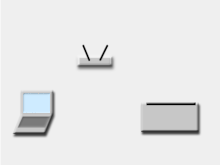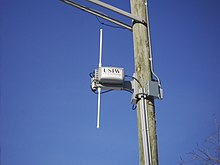Wi-Fi or WiFi is a technology for wireless local area networking with devices based on the IEEE 802.11 standards. Wi-Fi is a trademark of the Wi-Fi Alliance, which restricts the use of the term Wi-Fi Certified to products that successfully complete interoperability certification testing.[1]
Devices that can use Wi-Fi technology include personal computers, video-game consoles, smartphones, digital cameras, tablet computers, smart TVs, digital audio players and modern printers. Wi-Fi compatible devices can connect to the Internet via a WLAN and a wireless access point. Such an access point (or hotspot) has a range of about 20 meters (66 feet) indoors and a greater range outdoors. Hotspot coverage can be as small as a single room with walls that block radio waves, or as large as many square kilometres achieved by using multiple overlapping access points.
Wi-Fi most commonly uses the 2.4 gigahertz (12 cm) UHF and 5 gigahertz (6 cm) SHF ISM radio bands. Having no physical connections, it is more vulnerable to attack than wired connections, such as Ethernet.
IEEE 802.11 standard[edit]
The IEEE 802.11 standard is a set of media access control (MAC) and physical layer(PHY) specifications for implementing wireless local area network (WLAN) computer communication in the 2.4, 3.6, 5, and 60 GHz frequency bands. They are created and maintained by the IEEE LAN/MAN Standards Committee (IEEE 802). The base version of the standard was released in 1997, and has had subsequent amendments. The standard and amendments provide the basis for wireless network products using the Wi-Fi brand. While each amendment is officially revoked when it is incorporated in the latest version of the standard, the corporate world tends to market to the revisions because they concisely denote capabilities of their products.[35] As a result, in the market place, each revision tends to become its own standard.
Uses[edit]
To connect to a Wi-Fi LAN, a computer has to be equipped with a wireless network interface controller. The combination of computer and interface controller is called a station. For all stations that share a single radio frequency communication channel, transmissions on this channel are received by all stations within range.[37] The transmission is not guaranteed to be delivered and is therefore a best-effort deliverymechanism. A carrier wave is used to transmit the data. The data is organised in packets on an Ethernet link, referred to as "Ethernet frames".[38]
Internet access[edit]
Wi-Fi technology may be used to provide Internet access to devices that are within the range of a wireless network that is connected to the Internet. The coverage of one or more interconnected access points (hotspots) can extend from an area as small as a few rooms to as large as many square kilometres. Coverage in the larger area may require a group of access points with overlapping coverage. For example, public outdoor Wi-Fi technology has been used successfully in wireless mesh networks in London, UK. An international example is Fon.
Wi-Fi provides service in private homes, businesses, as well as in public spaces at Wi-Fi hotspots set up either free-of-charge or commercially, often using a captive portal webpage for access. Organizations and businesses, such as airports, hotels, and restaurants, often provide free-use hotspots to attract customers. Enthusiasts or authorities who wish to provide services or even to promote business in selected areas sometimes provide free Wi-Fi access.
Routers that incorporate a digital subscriber line modem or a cable modem and a Wi-Fi access point, often set up in homes and other buildings, provide Internet access and internetworking to all devices connected to them, wirelessly or via cable.
Similarly, battery-powered routers may include a cellular Internet radiomodem and Wi-Fi access point. When subscribed to a cellular data carrier, they allow nearby Wi-Fi stations to access the Internet over 2G, 3G, or 4G networks using the tetheringtechnique. Many smartphones have a built-in capability of this sort, including those based on Android, BlackBerry, Bada, iOS(iPhone), Windows Phone and Symbian, though carriers often disable the feature, or charge a separate fee to enable it, especially for customers with unlimited data plans. "Internet packs" provide standalone facilities of this type as well, without use of a smartphone; examples include the MiFi- and WiBro-branded devices. Some laptops that have a cellular modem card can also act as mobile Internet Wi-Fi access points.
Wi-Fi also connects places that normally don't have network access, such as kitchens and garden sheds.
Google is intending to use the technology to allow rural areas to enjoy connectivity by utilizing a broad mix of projection and routing services. Google also intends to bring connectivity to Africa and some Asian lands by launching blimps that will allow for internet connection with Wi-Fi technology.[39]
City-wide Wi-Fi[edit]
In the early 2000s, many cities around the world announced plans to construct citywide Wi-Fi networks. There are many successful examples; in 2004, Mysorebecame India's first Wi-Fi-enabled city. A company called WiFiyNet has set up hotspots in Mysore, covering the complete city and a few nearby villages.[40]
In 2005, St. Cloud, Florida and Sunnyvale, California, became the first cities in the United States to offer citywide free Wi-Fi (from MetroFi).[41] Minneapolis has generated $1.2 million in profit annually for its provider.[42]
In May 2010, London, UK, Mayor Boris Johnson pledged to have London-wide Wi-Fi by 2012.[43] Several boroughs including Westminster and Islington[44][45] already had extensive outdoor Wi-Fi coverage at that point.
Officials in South Korea's capital are moving to provide free Internet access at more than 10,000 locations around the city, including outdoor public spaces, major streets and densely populated residential areas. Seoul will grant leases to KT, LG Telecom and SK Telecom. The companies will invest $44 million in the project, which was to be completed in 2015.[46]
Campus-wide Wi-Fi[edit]
Many traditional university campuses in the developed world provide at least partial Wi-Fi coverage. Carnegie Mellon University built the first campus-wide wireless Internet network, called Wireless Andrew, at its Pittsburgh campus in 1993 before Wi-Fi branding originated.[47][48][49] By February 1997 the CMU Wi-Fi zone was fully operational. Many universities collaborate in providing Wi-Fi access to students and staff through the Eduroam international authentication infrastructure.
Wi-Fi ad hoc versus Wi-Fi direct[edit]
Wi-Fi also allows communications directly from one computer to another without an access point intermediary. This is called ad hoc Wi-Fi transmission. This wireless ad hoc network mode has proven popular with multiplayer handheld game consoles, such as the Nintendo DS, PlayStation Portable, digital cameras, and other consumer electronics devices. Some devices can also share their Internet connection using ad hoc, becoming hotspots or "virtual routers".[50]
Similarly, the Wi-Fi Alliance promotes the specification Wi-Fi Direct for file transfers and media sharing through a new discovery- and security-methodology.[51] Wi-Fi Direct launched in October 2010.[52]
Another mode of direct communication over Wi-Fi is Tunneled Direct Link Setup (TDLS), which enables two devices on the same Wi-Fi network to communicate directly, instead of via the access point.[53]
Download
IEEE 802.11 standard[edit]
The IEEE 802.11 standard is a set of media access control (MAC) and physical layer(PHY) specifications for implementing wireless local area network (WLAN) computer communication in the 2.4, 3.6, 5, and 60 GHz frequency bands. They are created and maintained by the IEEE LAN/MAN Standards Committee (IEEE 802). The base version of the standard was released in 1997, and has had subsequent amendments. The standard and amendments provide the basis for wireless network products using the Wi-Fi brand. While each amendment is officially revoked when it is incorporated in the latest version of the standard, the corporate world tends to market to the revisions because they concisely denote capabilities of their products.[35] As a result, in the market place, each revision tends to become its own standard.
Uses[edit]
To connect to a Wi-Fi LAN, a computer has to be equipped with a wireless network interface controller. The combination of computer and interface controller is called a station. For all stations that share a single radio frequency communication channel, transmissions on this channel are received by all stations within range.[37] The transmission is not guaranteed to be delivered and is therefore a best-effort deliverymechanism. A carrier wave is used to transmit the data. The data is organised in packets on an Ethernet link, referred to as "Ethernet frames".[38]
Internet access[edit]
Wi-Fi technology may be used to provide Internet access to devices that are within the range of a wireless network that is connected to the Internet. The coverage of one or more interconnected access points (hotspots) can extend from an area as small as a few rooms to as large as many square kilometres. Coverage in the larger area may require a group of access points with overlapping coverage. For example, public outdoor Wi-Fi technology has been used successfully in wireless mesh networks in London, UK. An international example is Fon.
Wi-Fi provides service in private homes, businesses, as well as in public spaces at Wi-Fi hotspots set up either free-of-charge or commercially, often using a captive portal webpage for access. Organizations and businesses, such as airports, hotels, and restaurants, often provide free-use hotspots to attract customers. Enthusiasts or authorities who wish to provide services or even to promote business in selected areas sometimes provide free Wi-Fi access.
Routers that incorporate a digital subscriber line modem or a cable modem and a Wi-Fi access point, often set up in homes and other buildings, provide Internet access and internetworking to all devices connected to them, wirelessly or via cable.
Similarly, battery-powered routers may include a cellular Internet radiomodem and Wi-Fi access point. When subscribed to a cellular data carrier, they allow nearby Wi-Fi stations to access the Internet over 2G, 3G, or 4G networks using the tetheringtechnique. Many smartphones have a built-in capability of this sort, including those based on Android, BlackBerry, Bada, iOS(iPhone), Windows Phone and Symbian, though carriers often disable the feature, or charge a separate fee to enable it, especially for customers with unlimited data plans. "Internet packs" provide standalone facilities of this type as well, without use of a smartphone; examples include the MiFi- and WiBro-branded devices. Some laptops that have a cellular modem card can also act as mobile Internet Wi-Fi access points.
Wi-Fi also connects places that normally don't have network access, such as kitchens and garden sheds.
Google is intending to use the technology to allow rural areas to enjoy connectivity by utilizing a broad mix of projection and routing services. Google also intends to bring connectivity to Africa and some Asian lands by launching blimps that will allow for internet connection with Wi-Fi technology.[39]
City-wide Wi-Fi[edit]
In the early 2000s, many cities around the world announced plans to construct citywide Wi-Fi networks. There are many successful examples; in 2004, Mysorebecame India's first Wi-Fi-enabled city. A company called WiFiyNet has set up hotspots in Mysore, covering the complete city and a few nearby villages.[40]
In 2005, St. Cloud, Florida and Sunnyvale, California, became the first cities in the United States to offer citywide free Wi-Fi (from MetroFi).[41] Minneapolis has generated $1.2 million in profit annually for its provider.[42]
In May 2010, London, UK, Mayor Boris Johnson pledged to have London-wide Wi-Fi by 2012.[43] Several boroughs including Westminster and Islington[44][45] already had extensive outdoor Wi-Fi coverage at that point.
Officials in South Korea's capital are moving to provide free Internet access at more than 10,000 locations around the city, including outdoor public spaces, major streets and densely populated residential areas. Seoul will grant leases to KT, LG Telecom and SK Telecom. The companies will invest $44 million in the project, which was to be completed in 2015.[46]
Campus-wide Wi-Fi[edit]
Many traditional university campuses in the developed world provide at least partial Wi-Fi coverage. Carnegie Mellon University built the first campus-wide wireless Internet network, called Wireless Andrew, at its Pittsburgh campus in 1993 before Wi-Fi branding originated.[47][48][49] By February 1997 the CMU Wi-Fi zone was fully operational. Many universities collaborate in providing Wi-Fi access to students and staff through the Eduroam international authentication infrastructure.
Wi-Fi ad hoc versus Wi-Fi direct[edit]
Wi-Fi also allows communications directly from one computer to another without an access point intermediary. This is called ad hoc Wi-Fi transmission. This wireless ad hoc network mode has proven popular with multiplayer handheld game consoles, such as the Nintendo DS, PlayStation Portable, digital cameras, and other consumer electronics devices. Some devices can also share their Internet connection using ad hoc, becoming hotspots or "virtual routers".[50]
Similarly, the Wi-Fi Alliance promotes the specification Wi-Fi Direct for file transfers and media sharing through a new discovery- and security-methodology.[51] Wi-Fi Direct launched in October 2010.[52]
Another mode of direct communication over Wi-Fi is Tunneled Direct Link Setup (TDLS), which enables two devices on the same Wi-Fi network to communicate directly, instead of via the access point.[53]















0 comments